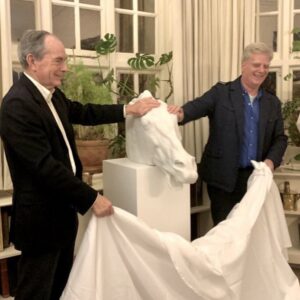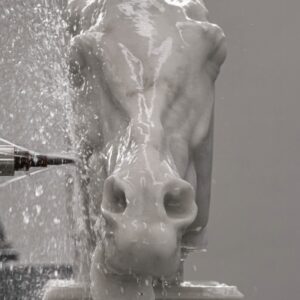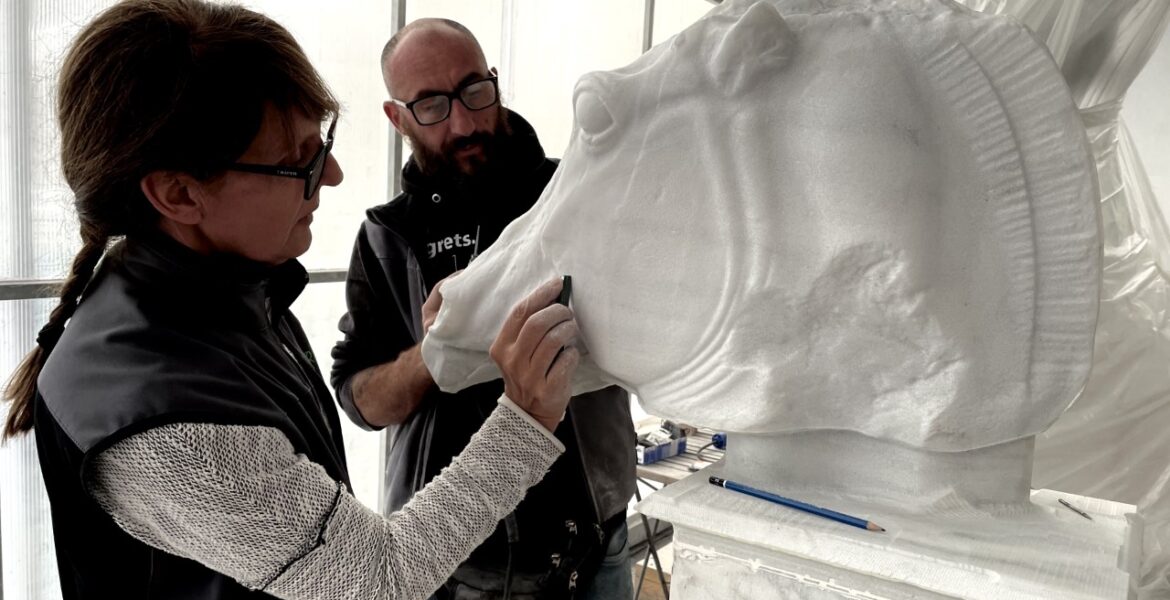Founder and Director of the Institute for Digital Archaeology, Roger Michel, says that the British Museum is well-behind the times when it comes to their Parthenon Marbles display, and the Institute’s Selene Horse proves it.
Speaking on the latest episode of the Ouzo Talk Podcast, Michel, along with Technical Director Alexy Karenowska, recounted their now infamous tale about how after being denied permission to scan the Parthenon Marbles by the British Museum, they went ahead and did it anyway, ultimately producing a sub-millimetre perfect copy of the Selene Horse in Pentelic Marble.
The existence – and quality – of the reproduction, has thrown further fuel on the fire of calls for the UK and the British Museum to return the Marbles to Athens to be exhibited at the Acropolis Museum, paving the way for a more creative, interactive and meaningful display to be installed at the British Museum.
According to Michel, it’s time for the British Museum to begin considering what the Duveen Gallery might look like in the future.
“There’s a famous painting (from) 1818-1819 showing Elgin himself, sitting in the Duveen Gallery with the Parthenon Sculptures arrayed around him,” said Michel.
“You look at that painting and you realise that nothing has changed in that room in 200 years – well, the only thing that’s changed is they’ve scraped them with steel brushes and they poured hydrochloric acid on them – but they’ve done nothing to improve the interpretation, to improve the context in which they’re displayed, at a time when there’s all types of interesting technologies available to enhance the visitor experience and to do a better job of teaching people about history.
“Imagine going into the British Museum and instead of seeing the same thing that Elgin saw in 1818, you saw an amazing exhibition that allows you to regress these things, that shows them somehow in context through virtual reality or augmented reality.
“The British Museum is bringing people into the BM, showing people these objects in a state which in no way reflects how they looked when they came out of Phidias’ studio. When they emerged from Phidias’ studio, number one, they were all intact. All the fingers and toes, and arms and legs were attached. But more important than that, they were brightly coloured, and on top of that they were also attached to a building.
“All of that is lost when they go to the Duveen Gallery.
“It’d be like trying to teach people about the Italian Renaissance and you take them to a room with a bunch of Caravaggio’s and all the paint’s missing on the paintings, and the canvases are torn. Nobody learns anything about the Italian Renaissance that way. I would put it to you that no-one is learning anything meaningful about the aesthetics of fifth century BC Greece by looking at those objects because they look nothing like the objects that Phidias produced.”
For his part, Michel isn’t concerned about whether the British Museum uses the digital solutions that his Institute for Digital Archaeology is offering – it’s all about showing what could be possible.



“There’s all kinds of reasons to think that what we’re doing – whether it’s our project or somebody else’s project – that there are technical solutions to this,” says Michel.
“There are things the British Museum could and should be doing to exploit technology in a way to allow them to do a better job of what they claim their function is – that is to educate people about history – and they’re just not doing it now.
“We’ve offered to do various versions (of the Parthenon Marbles). We’ve offered to regress these things back to the state in which they existed when they were first carved, we’ve offered to restore the colours – we’ve offered to do all kinds of interesting things that I think will get people excited, but more importantly, give them a real sense of what these items are all about.
“We obviously have a fractious relationship with the British Museum now for all the reasons that you know very well – all the guerrilla tactics. Maybe we’ve burned too many bridges for it to be us. It’s like ‘go down Moses’ – maybe we can lead them to the promised land but we can’t go down into the valley.
“Maybe the most important thing we did was to really challenge the BM, who for 20 years have been saying; ‘oh, we need these objects to teach people about history and won’t it be a shame if they go back to Greece, because then people won’t have a chance to learn about history’.
“We said; ‘wait a minute, you’re not teaching people anything meaningful about history. If you’re serious about teaching people about history, we’ll show you how to do it. You don’t have to let us show you how to do it, but we’ll show it can be done.
“You can pick someone that you like better, or who doesn’t bug you as much as we do, but we’ll show you the way, and we’ll point out the extent to which what you’re saying about why you need these sculptures is bullshit. It’s absolutely not true that they’re doing anything meaningful to teach people about history with objects that don’t look like the objects that were created in the fifth century BC.”
The Ouzo Talk podcast is available on all major podcast streaming apps, including Apple Podcasts, Spotify, Google Podcasts, SOUNDIS.GR and more. Subscribe on your favourite platform so you never miss an episode.
Read also Mitsotakis: Greece will be at the Frontline to Assist Turkey


